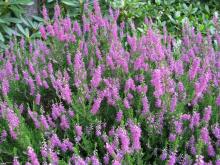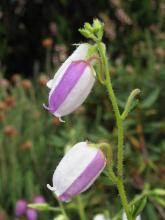Gardening with Hardy Heathers, David Small and Ella May T. Wulff, Timber Press, Portland, Oregon (September 10, 2008); 296pps, 214 color photos, 1 b/w illustration, 2 charts, 17 maps; hardcover; publisher's price: NA; Amazon price: $15.98.
Who better than the late David Small, heather propagator extraordinaire and leading light of Britain’s Heather Society, and Ella May Wulff, past president of the North American Heather Society, to write a comprehensive volume on their favorite plants? This alliance of British and American wisdom is another in the Timber Press series of expert-written texts devoted to a single genus.
I encountered heaths and heathers in my first spring of field work for clients as a fledgling professional gardener over a decade ago. I was struck by their beauty and utility in otherwise hard to plant spots such as low banks. With drought tolerance (once established) and simple care by shearing in spring for heathers and summer for heaths, these plants fit today’s mandate for the “low maintenance”garden.
Before long, I had joined the local chapter of the North American Heather Society here in the Northeast to learn more about these plants. On an early fall weekend trip to Brandywine Valley gardens sponsored by our chapter, I met Ella May. Soon she was picking my brain for ideas about design and companion planting with heathers. What a happy surprise to learn that she was writing this book and would include my suggestions!
A great feature of the text is the season of bloom and soil pH preferences chart for both the spring blooming Ericas (heaths) and the summer blooming Callunas (heathers). Daboecias are also included, but these arenʼt hardy for me here in zone 5. Excellent photos and variety descriptions follow. This information is extremely helpful for anyone working to decipher nursery catalogue listings, aiming to pick the right plant for the right place.

I also like the special uses charts near the end of the book, with such headings as “early bloomers,” “edgers,” and “rock gardens, sinks and troughs.” Winter foliage color is also one of the key headings, and this is one of the great reasons to grow these plants! Many heaths do not bloom but sport changing foliage as the year turns.
While on the topic of winter, however, there is just brief mention in the volume about the techniques we here in the Northeast must never fail to use to keep our favorite plants alive. If only we knew in advance what kind of winter we were about to get! Since this will never be, I recommend precaution. Ericas are low, tough plants and can go with minimal protection such as a mulch of pine needles. However, Callunas may succumb to desiccating winds while the ground is frozen and snow cover is lacking. A tip: We cover them with 6" of pine needles and then a layer of evergreen boughs once the ground is frozen. This winter mulch can be removed in late March or early April. Then the plants beneath are sheared and spruced up for another season.
For those with a yen to propagate, David Small reveals all in Chapter 3, including layering, dropping, cuttings and seed. The timing of these activities during the gardening season is also outlined clearly with charts. His discussion of heather breeding will also be of interest.
Check out the listings in the back of the book for gardens to visit, nursery and designer listings, and a helpful glossary. Above all, enjoy this highly readable reference!
Priscilla Hutt Williams is President of Pumpkin Brook Organic Gardening in Townsend, Massachusetts. She is a board member of the Northeast Heather Society and a member of the New England chapter of NARGS.


